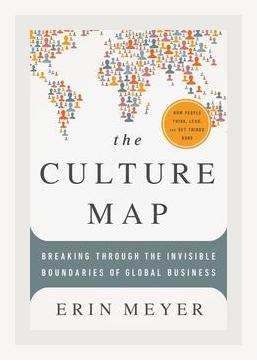Leadership and ManagementInnovation Leadership
Introduction:
Erin Meyer’s “The Culture Map” (2014) is an insightful exploration into how cultural differences impact business practices and interactions around the world. As an expert in cross-cultural management, Meyer provides a systematic way to understand and navigate these differences effectively. This book primarily falls under the categories of Innovation and Leadership. It introduces eight scales that help decode cultural complexities, enabling leaders to function effectively in diverse environments.
The Eight Scales of Culture Mapping
- Communicating: Low-Context vs. High-Context
- In low-context cultures like the United States, communication is explicit, clear, and direct. Conversely, high-context cultures such as Japan rely on nuanced, implicit communication with much left unsaid.
- Example: An American might say, “Please correct the errors in this document,” while a Japanese colleague might suggest, “It would be great if the document could be improved.”
-
Actionable Tip: When dealing with high-context cultures, keenly observe body language and context, and when communicating with low-context cultures, strive to be as clear and concise as possible.
-
Evaluating: Direct Negative Feedback vs. Indirect Negative Feedback
- Direct feedback is customary in cultures like the Netherlands, while indirect feedback is more common in countries such as Japan.
- Example: A Dutch manager might say, “This is wrong,” while a Japanese manager might say, “Perhaps we could consider an alternative approach.”
-
Actionable Tip: Modulate your feedback. Use a “feedback sandwich” (positive-negative-positive) approach in indirect cultures and be prepared for bluntness in direct cultures.
-
Persuading: Applications-First vs. Principles-First
- Cultures such as the U.S. are applications-first, focusing on pragmatic, data-driven approaches. In contrast, France leans towards principles-first, where theoretical frameworks and general principles take precedence.
- Example: An American business plan might highlight “Here’s how this will work,” while a French plan might start with “The philosophy behind this is…”
-
Actionable Tip: Tailor your presentations. Emphasize data and practical outcomes for applications-first cultures and robust logic and theory for principles-first cultures.
-
Leading: Egalitarian vs. Hierarchical
- Egalitarian cultures like Denmark value flat organizational structures, while hierarchical cultures such as India prefer clear rank and authority distinctions.
- Example: In Denmark, team decisions are often expected, while in India, deferring to the boss’s decision is the norm.
-
Actionable Tip: Adapt your leadership style. Encourage open dialogue and decentralization in egalitarian settings, and acknowledge titles and formal chain of command in hierarchical settings.
-
Deciding: Consensual vs. Top-Down
- Consensual cultures (e.g., Japan) take time to make decisions through comprehensive agreement, while top-down cultures (e.g., China) have quicker, leader-driven decision processes.
- Example: Japanese businesses may have protracted meetings to reach consensus, while Chinese leaders might announce a decision which is then executed by the team.
-
Actionable Tip: When working with consensual cultures, be patient and engage all stakeholders. In top-down cultures, seek clarity from leadership and follow directives.
-
Trusting: Task-Based vs. Relationship-Based
- Task-based cultures like the U.S. build trust through professional competence and reliability, whereas relationship-based cultures (e.g., Brazil) foster trust through long-term personal connections.
- Example: In the U.S., completing a project on time builds trust. In Brazil, having multiple casual dinners and social interactions might be required before sealing a deal.
-
Actionable Tip: Invest time in personal interactions and relationship-building activities in relationship-based cultures, while focusing on delivering results and demonstrating competence in task-based cultures.
-
Disagreeing: Confrontational vs. Avoids Confrontation
- Confrontational cultures such as Israel view open debate positively, while non-confrontational cultures like Japan avoid public disagreement.
- Example: Israeli colleagues might welcome a heated debate on a conference call, whereas Japanese colleagues may remain silent to avoid conflict.
-
Actionable Tip: Adapt your approach to disagreements. Encourage and moderate debates in confrontational cultures, and seek one-on-one meetings or indirect methods to address conflicts in non-confrontational cultures.
-
Scheduling: Linear-Time vs. Flexible-Time
- Linear-time cultures like Germany are punctual and strictly adhere to schedules. Flexible-time cultures such as India see schedules as adaptable, emphasizing adaptability over punctuality.
- Example: A German project might have a detailed, rigid timeline, while an Indian project plan could be more adjustable and fluid.
- Actionable Tip: In linear-time cultures, respect deadlines and punctuality. In flexible-time cultures, maintain flexibility and prepared for changes.
Practical Implications and Strategies
- Global Team Management
- Point: Global teams often bring together members from diverse cultural backgrounds. Misunderstandings can arise, affecting performance and morale.
- Example: An American manager leading a global team might assume consensus through silence, while team members from an indirect feedback culture might be harboring unvoiced concerns.
-
Actionable Tip: Regularly seek feedback in multiple formats—written, verbal, and anonymous—to ensure all voices are heard.
-
Negotiation Tactics
- Point: Negotiations can be influenced by cultural differences in communication and persuasion.
- Example: A French negotiator might elaborate on the theoretical underpinnings of a proposal, while an American negotiator focuses on practical benefits and outcomes.
-
Actionable Tip: Study the negotiation styles and preparation methods of the cultures involved. Flexibly adapt your strategies to align with or counterbalance these styles.
-
Conflict Resolution
- Point: Handling conflicts effectively requires cultural empathy and awareness.
- Example: Confrontation might be productive in resolving issues in a confrontational culture, but could lead to resentment in a culture that avoids confrontation.
- Actionable Tip: Train managers in conflict resolution techniques suitable for the specific cultural context of their teams.
Conclusion
Erin Meyer’s “The Culture Map” provides a robust framework for understanding and bridging cultural gaps in business contexts. By leveraging insights from the eight scales and applying the actionable tips, leaders can navigate cultural complexities effectively, fostering more harmonious and productive international collaborations. This summary covers the primary points and examples from the book, offering practical steps for applying its teachings in real-world scenarios across diverse cultural landscapes.
